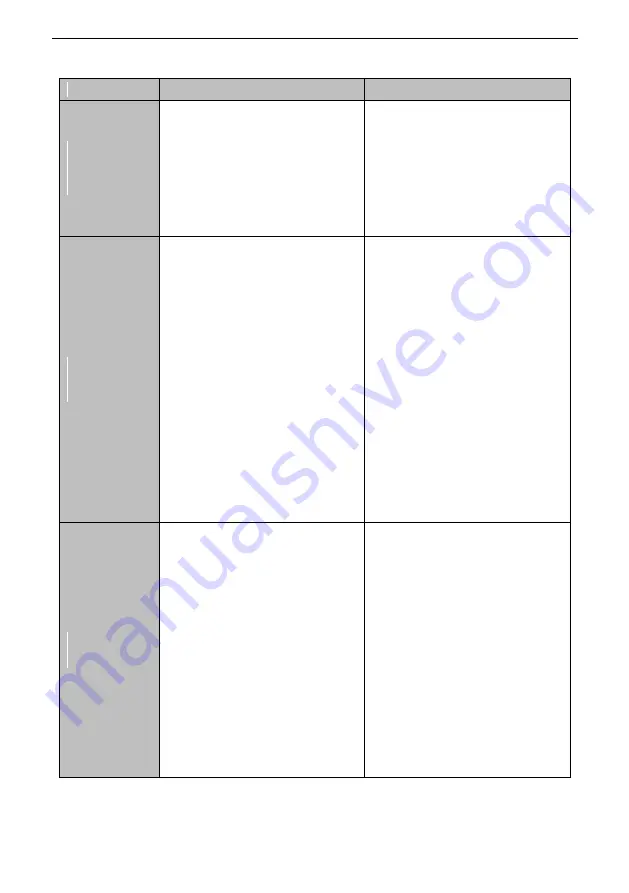
SV800/SV800A User Manual 5 Introduction of operation and running
71
Table 5-1 Summary Table for Self-Learning
DC mode self-learning
Full mode self-learning
Self-learning
implementati
on conditions
Input the induction motor nameplate
parameters correctly (b1-00 to b1-06, or b2-00
to b2-06)
The pulse number of PG must be
correctly input under close-loop vector control
mode (b1-07 or b2-07)
Motor and the transmission machinery
not need to be separated
Input the induction motor nameplate
parameters correctly (b1-00 to b1-06, or b2-00
to b2-06)
The pulse number of PG must be
correctly input under close-loop vector control
mode (b1-07 or b2-07)
As far as possible, separate the motor is
from the transmission machinery in a single
state
Self-learning
detection
parameter
Static time compensation constant
(visible to manufacturers)
Frequency inverter nonlinear
parameters (visible to manufacturers)
Motor primary side resistance and
motor wiring resistance (b1-08 or b2-08)
Note
: In vector control mode, if you need to
replace the main control board or the inverter,
please ensure that the electrical parameters
(b1-08 to b1-16, or b2-08 to b2-16) are correct
after performing DC mode. You can choose the
upload and download function of the keyboard.
Use (A0-07) to upload the parameters before
replacing and download the parameters to the
replaced inverter. Thereafter perform DC mode
self-learning. You can also enter electrical
parameters manually after the DC mode
self-learning finished.
Static time compensation constant
(manufacturer's visibility)
Frequency inverter nonlinear
parameters (visible to manufacturers)
Motor primary side resistance and
motor wiring resistance (b1-08 or b2-08)
Motor secondary side resistance (b1-09
or b2-09)
Motor leakage inductance (b1-10 or
b2-10)
Motor mutual inductance (b1-11 or
b2-11)
Motor inductance saturation
compensation coefficient (b1-12, b1-13 or
b2-12, b2-13)
Motor iron loss conductance (b1-14 or
b2-14)
Motor mechanical loss coefficients
(b1-15, b1-16 or b2-15, b2-16)
Self-learning
motor state
Due to the mechanical symmetry
deviation of the three-phase winding, there will
be slight jitters at the beginning of the
self-learning. After rotate forward at low speed
for a half cycle, and then rotate reverse at low
speed for a half cycle, the self-learning finish.
Note:
Because DC mode self-learning does not
require motor rotation, self-learning can be
performed when the motor is loaded or has
mechanical brake. At this time, the motor will
neither shake nor reverse speed.
Due to the mechanical symmetry
deviation of the three-phase winding, there will
be slight jitters at the beginning of the
self-learning. Then the motor will become
static. After a period of time, the motor will
accelerate to 80% of the rated rotating speed of
the motor and then decelerate to zero speed.
After rotate forward at low speed for a half
cycle, and then rotate reverse at low speed for a
half cycle, the self-learning finish.
Note:
Please remove the load or mechanical
brake from the motor when perform full-mode
self-learning.
If the motor can not rotate during
the full-mode self-learning, the detected
electrical parameters would be wrong, which
may cause the motor to fail to run or even cause
inestimable danger.
Note: It is recommended to perform the motor self-learning at ambient temperature (25 °C). Do not perform
self-learning after the motor runs out of heat, otherwise it will result in inaccurate parameters for
constructing the motor mathematical model and lead to motor control accuracy decrease. Temperature
Summary of Contents for SV800 Series
Page 8: ......






























